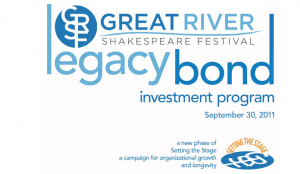 The Great River Shakespeare Festival (GRSF) in Winona, Minnesota has created an inventive capitalization instrument that will interest the broader field. The Festival’s “Legacy Bond Investment Program,” launched in September, 2011 is a state-approved investment offer for Festival patrons that provides GRSF with significant working capital. Â Essentially, GRSF is offering donors the opportunity to support the organization through interest-bearing loans, with the idea being relatively small loans ($5,000) from a relatively large number of investors (100).
The Great River Shakespeare Festival (GRSF) in Winona, Minnesota has created an inventive capitalization instrument that will interest the broader field. The Festival’s “Legacy Bond Investment Program,” launched in September, 2011 is a state-approved investment offer for Festival patrons that provides GRSF with significant working capital. Â Essentially, GRSF is offering donors the opportunity to support the organization through interest-bearing loans, with the idea being relatively small loans ($5,000) from a relatively large number of investors (100).
I stopped by the GRSF storefront office last week while in Winona to talk to Managing Director Eric Bunge and learn more about the program, which is described fully on the GRSF website. He explained the program’s development and told me there’s a waiting list for purchasers.
Here’s how it works:
– The Board of Directors of GRSF authorized the sale of 100 Legacy Bonds.
– Investors pay $5,000 to purchase a bond. Multiple bonds can be purchased by a single person.
– GRSF returns $200 in interest annually to the bondholder for an annual return of 4 percent. (The current passbook savings rate is less than 1 percent.)
– Investors sign a legal agreement that was submitted to and approved by Securities Division of Minnesota’s Commerce Department. The agreement explains the program’s risks and returns and details each party’s obligations.
– Bonds may be called after September 30, 2021 (ten years) and GRSF will then have 180 days to repay the bond (plus any accrued interest). GRSF may also repay the bond to the investor after the same date.
– Bonds may be transferred and gifted provided the proper notifications and paperwork are completed.
– GRSF has built a multi-year financial plan that calls for surpluses to pay interest and pay back the bonds over time. Bunge projects the organization to operate with its first surplus this year.
– The expectation is that after 10 years, many investors will choose to roll the bonds over to a new term.
Bunge, who has been in his role for about a year, developed the program as a way raise funds quickly to address the organization’s acute capitalization needs. When he started work, GRSF had debt of nearly $200,000 that was being financed with short-term bank loans at very high rates of interest. Dealing with the debt was expensive, and, as importantly, it was a distraction that occupied the organization as it worked to build creatively on its growth potential.
So far GRSF has sold 39 of the bonds. (GRSF is timing the sale of additional bonds so as not to require an interest payout if the capital is not needed immediately, although you could buy one tomorrow if you want one!) Short term, high-interest bank debt has been paid off, and GRSF has used its new working capital to invest in infrastructure. Most recently GRSF purchased new computer systems and software to support box office and development functions. GRSF had sufficient capital to risk extending its season by a week in 2012, in response to audience demand, and is working to expand its street presence in the beautiful river town of Winona. So far, ticket sales this year have been brisk.
I can imagine a number of instances where a bond program could be extremely useful to an organization paying high interest on debt of any kind, or for an organization that needs working capital to launch new programs or enterprises and can’t wait for the typical 9-12 month grant cycle to seize the opportunity. It seems ideal for artistic investments — for major projects, season expansion or brand new programs and services. With legal and filing fees “under $2,000,†Bunge encourages other people to be in touch to learn more. But maybe wait until the Festival’s summer season is over on August 5th!
